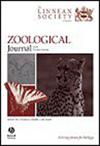Unravelling cryptic diversity in the Paratrichodorus allius-group species complex to resolve eight new species of the genus and new insights on the molecular phylogeny (Nematoda: Trichodoridae)
IF 3
2区 生物学
Q1 ZOOLOGY
引用次数: 0
Abstract
The stubby-root nematode genus Paratrichodorus comprises species of plant polyphagous ectoparasitic nematodes distributed worldwide and a few of them are plant virus-vectors (tobravirus). This is one of the most difficult nematode genera in terms of species identification, since it is phenotypically conserved with closely related species and is highly sensitive to the specimen fixation and preservation processes. Using an integrative and multidisciplinary taxonomy framework, we determined species boundaries among the Paratrichodorus populations from a P. allius species-complex sampled in cultivated and natural ecosystems across Spain. We support the hypothesis that nematode diversity of the P. allius species-complex remains underestimated and describe here a total of eight new species on the basis of detailed morphological and molecular characterization of 16 Paratrichodorus populations: Paratrichodorus asidonaensis sp. nov., Paratrichodorus benalupensis sp. nov., Paratrichodorus hinogerus sp. nov., Paratrichodorus litoralis sp. nov., Paratrichodorus paraallius sp. nov., Paratrichodorus rocianerus sp. nov., Paratrichodorus tarifaensis sp. nov., and Paratrichodorus uliaensis sp. nov. This study emphasizes the importance of properly applying a broad taxonomic framework in plant-parasitic nematodes. It is also relevant for plant health, since it correctly delimits species morphologically closed to the virus vector nematode, P. allius, and gives proper molecular markers for its unequivocal identification.揭示 Paratrichodorus allius 群物种复合体的隐秘多样性,解析该属的 8 个新物种,以及对分子系统发育的新认识(线虫纲:毛线虫科)
茎根线虫属(Paratrichodorus)由分布于世界各地的植物多食性外寄生线虫组成,其中一些是植物病毒(tobravirus)的传播者。这是在物种鉴定方面最困难的线虫属之一,因为它在表型上与近缘物种保持一致,而且对标本固定和保存过程高度敏感。我们利用综合的多学科分类框架,确定了在西班牙栽培和自然生态系统中采样的 Paratrichodorus 种群之间的物种界限。根据对 16 个 Paratrichodorus 种群进行的详细形态学和分子鉴定,我们共描述了 8 个新物种:新种 Paratrichodorus asidonaensis sp.nov.、新种 Paratrichodorus benalupensis sp.nov.、新种 Paratrichodorus hinogerus sp.nov.、新种 Paratrichodorus litoralis sp.nov.、新种 Paratrichodorus paraallius sp.nov.、新种 Paratrichodorus rocianerus sp.nov.、新种 Paratrichodorus tarifaensis sp.nov.和新种 Paratrichodorus uliaensis sp.nov.。这项研究强调了在植物寄生线虫中正确应用广泛的分类框架的重要性。这项研究还与植物健康有关,因为它正确地划分了与病毒载体线虫 P. allius 形态上接近的物种,并提供了适当的分子标记以明确识别。
本文章由计算机程序翻译,如有差异,请以英文原文为准。
求助全文
约1分钟内获得全文
求助全文
来源期刊
CiteScore
6.50
自引率
10.70%
发文量
116
审稿时长
6-12 weeks
期刊介绍:
The Zoological Journal of the Linnean Society publishes papers on systematic and evolutionary zoology and comparative, functional and other studies where relevant to these areas. Studies of extinct as well as living animals are included. Reviews are also published; these may be invited by the Editorial Board, but uninvited reviews may also be considered. The Zoological Journal also has a wide circulation amongst zoologists and although narrowly specialized papers are not excluded, potential authors should bear that readership in mind.

 求助内容:
求助内容: 应助结果提醒方式:
应助结果提醒方式:


